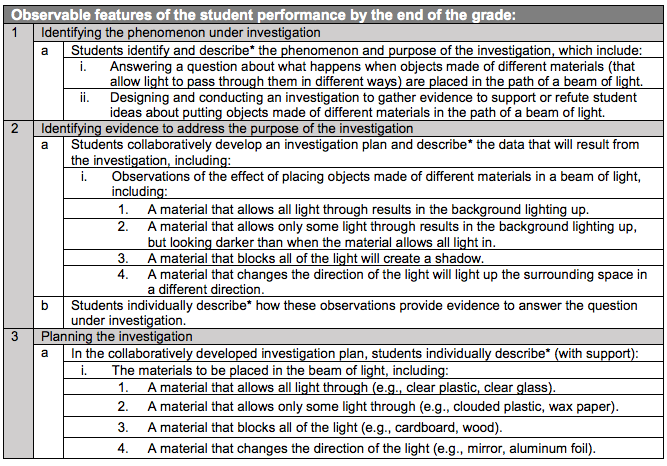Assessments based on the Next Generation Science Standards (NGSS) are coming to many states. To date, 18 states have adopted NGSS. Other states have or are adopting new science standards that are loosely based on or influenced by NGSS, and even those states who do not adopt the new standards may see their assessments shift to a more NGSS-like style.
So, what is NGSS? The goal of NGSS is for every student, not just a future Newton or Einstein, to understand science. It assumes that every citizen needs scientific knowledge to thrive in a modern society. According to Carl Wieman, a recipient of the Nobel Prize in physics and an early proponent of the standards, “...successful science education transforms how students think, so that they can understand and use science like scientists do.”
In many cases, science classes are not designed to help students achieve these new standards. Students might memorize facts, follow scripted experiments, and solve routine problems, but they aren’t learning biology, chemistry or any of the other sciences as defined by the NGSS. For instance, ACT measured high school graduates for college readiness benchmark levels in science. They found 64% of those taking the ACT in 2016 failed to meet these levels for biology.
Teachers and administrators may be asking questions. “How should I think about these new standards holistically?” How should science teachers approach the emerging need to prepare students for these new standards?”
What Makes NGSS Different? Thinking in Three Dimensions
The shift in content from old standards to the new NGSS doesn’t seem that radical.
For example, the 1998 California third-grade life-sciences standard reads: “Students know plants and animals have structures that serve different functions in growth, survival, and reproduction.” An equivalent third-grade NGSS life science standard reads: “Develop models to describe that organisms have unique and diverse life cycles but all have in common birth, growth, and reproduction.” The basic concepts and language look very similar.
The difference lies in the performance expectations to meet these standards. The NGSS framework expects students will “...focus on understanding and application as opposed to memorization of facts.” Rather than asking that students simply “know” the science of reproduction, the NGSS requires that they “develop models to describe” its processes.
Each NGSS standard contains not only science content but also science practices and principles. Every single standard is comprised of three areas, known as dimensions: Disciplinary Core Ideas (DCI), Science and Engineering Practices(SEP), and Crosscutting Concepts (CCC). Together they create “three dimensional learning” or simply 3D Learning. So, in 3-LS1-1, the basic Core Idea is reproduction, the SEP is use of models, and the CCC is patterns of change.
To be proficient in science, a student must demonstrate “3D” understanding. As stated in Science Connection, published by the Kentucky Department of Education, the student is expected to be “…the constructor of meaning through immersion in the science and engineering practices to learn core ideas and make connections to unifying science concepts.” This is a long way from the multiple-choice pop quiz.
A Field Trip to Daytona Beach: Real or Virtual
In 2017, schools will begin piloting assessments based on the NGSS. For instance, California high school students will take a pilot of the California Science Test (CAST) in January. What will students encounter in these assessments? How can teachers prepare them for success?
One important clue comes from the evidence statements that NGSS provides with the standards. These give the “observable features of the student performance” that teachers can use to assess a student’s mastery of a given standard. For instance, the 4-PS3-1 Evidence Statement (pictured below) asks students to use evidence to construct an explanation relating the speed of an object to the energy of that object.”

The basic structure of this evidence statement covers three parts: explain a phenomenon; find evidence to support the explanation; connect the evidence with reasoning as support. This is a typical pattern in which the SEP of a standard drives what a student does- whether they explain a phenomenon, use a model, or make an argument about the data.
Though the evidence standards provide a template for testing, teachers still face a large challenge in their classrooms. For students to explain a phenomenon, they must first observe or even experience it. In the case of the 4th grade standard, having to do with speed and energy, how can teachers demonstrate or recreate the phenomenon in class? Students may relate to race cars more than multiple choice worksheets, but the budget for most schools won’t cover a field trip to NASCAR.
While teachers could use matchbox cars to teach the concepts of speed and energy in their classrooms, online providers are also developing innovative tools that can enable teachers to present content in an interactive way that dives into process. Simulations, such as those created by PrepMagic, can help teachers deliver on the newer standards. As Carl Wieman has said, a simulation “…can be highly effective and takes less time to incorporate into instruction than more traditional materials.”
It may be reassuring to teachers to know that they can find assessments for the new standards that not only encourage deeper thought and greater mastery of the concepts, but are also more fun and engaging for their students.


